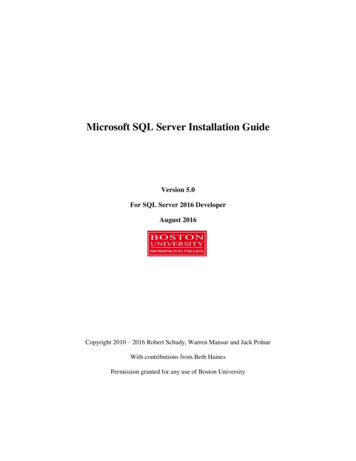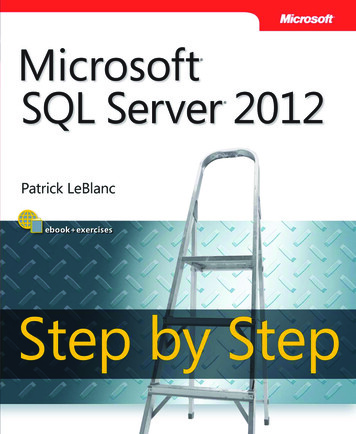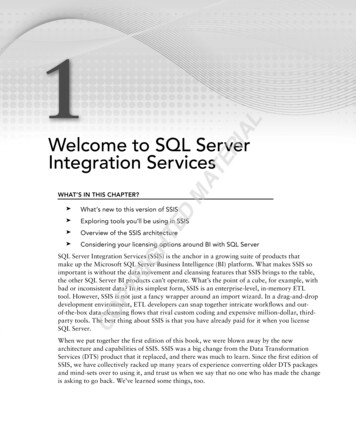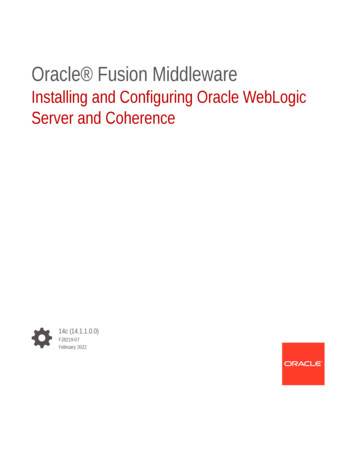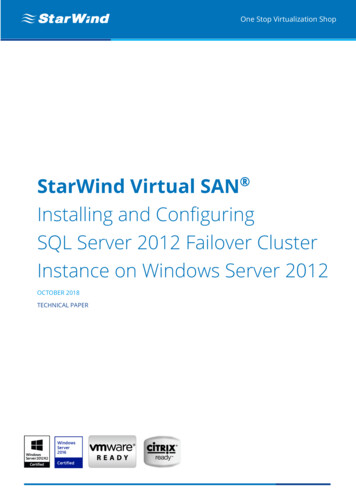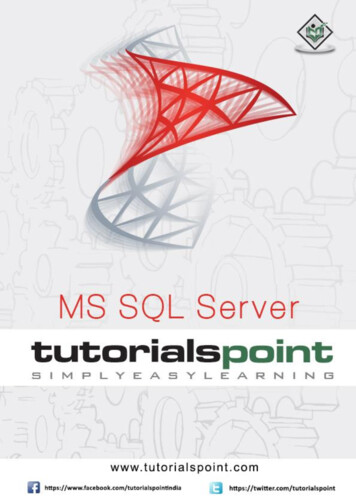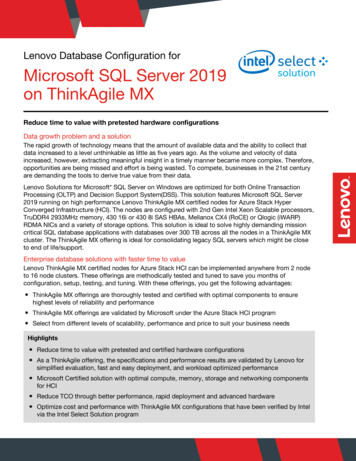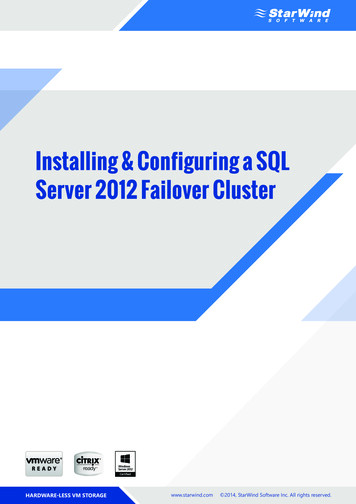
Transcription
Installing & Configuring a SQLServer 2012 Failover ClusterHARDWARE-LESS VM STORAGEwww.starwind.com 2014, StarWind Software Inc. All rights reserved.
CONTENTSIntroduction . 3Assumptions . 3Cluster Configuration Details . 3Connecting to the iSCSI Storage . 3Initializing and Formatting the Disks . 6Installing the .NET Framework 3.5 . 10Windows Failover Cluster Feature Installation . 11Windows Server Failover Clustering Configuration . 12SQL Server 2012 Failover Cluster Instance Installation - Install Primary (Initial) Cluster Node . 18SQL Server 2012 Failover Cluster Instance Installation - Install Secondary (Failover) Cluster Node . 29HARDWARE-LESS VM STORAGEwww.starwind.com 2014, StarWind Software Inc. All rights reserved.
INTRODUCTIONThe goal of this documentation is to provide a step-by-step procedure in configuring a 2-node Windows Server 2012Failover Cluster that will host a SQL Server 2012 Failover Clustered Instance.ASSUMPTIONSWhen using this guide, a few assumptions have been made: Windows Server 2012 is installed on each server that you will cluster and join to the domain. The disks (LUNs) that you want to use in the cluster are exposed to the servers that you will cluster and are configuredappropriately as per StarWind’s High Availability Best Practices documentation. You have decided which quorum model will be used by the failover cluster. This document will use the disk witness asthe quorum model.CLUSTER CONFIGURATION DETAILSPrior to building your cluster, it is important to have all the details in place to make sure that installation and configurationwill go smoothly. The following details will be used to build and configure a SQL Server 2012 Failover Clustered Instance.Active Directory Domain Name: TESTDOMAIN.localStarWind Server iSCSI SAN IP address: 10.0.0.200Cluster Nodes: WS-CLUSTER3 & WS-CLUSTER4Cluster Disks: Q:\, E:\, F:\ & H:\Windows Server Failover Cluster Name and IP Address: WINCLUSTER2 & 172.16.0.211SQL Server Failover Cluster Name and IP Address: SQLCLUSTER2 & 172.16.0.212SQL Server Service Account: TESTDOMAIN\sqlserviceCONNECTING TO THE ISCSI STORAGEWindows Server 2012 comes with iSCSI Initiator software that enables connection of a Windows host to an external iSCSIstorage array like StarWind Software’s iSCSI SAN using network adapters. You can launch the tool from the Server Managerdashboard, under Tools and select iSCSI Initiator.HARDWARE-LESS VM STORAGEwww.starwind.com 2014, StarWind Software Inc. All rights reserved.3
NOTE: These steps have to be performed on both of the servers that will act as nodes in your failover cluster.You will get a message saying that the Microsoft iSCSI service is not running. Simply click Yes to continue.To connect to the iSCSI target:1. In the iSCSI Initiator Properties page, under the Targets tab, enter the IP address of the StarWind server iSCSI SAN onthe Target field. Click Quick Connect. You should see a list of the iSCSI Targets that have been defined on your iSCSI SAN.HARDWARE-LESS VM STORAGEwww.starwind.com 2014, StarWind Software Inc. All rights reserved.4
2. In the Quick Connect dialog box, select the target that you will use and click Connect. Click Done to go back to theiSCSI Initiator Properties page.3. Click OK to close the iSCSI Initiator Properties page.Once the targets have been defined using the iSCSI Initiator tool, you can now bring the disks online, initialize them, andcreate new volumes using the Disk Management console.HARDWARE-LESS VM STORAGEwww.starwind.com 2014, StarWind Software Inc. All rights reserved.5
INITIALIZING AND FORMATTING THE DISKSAfter configuring the servers to connect to the iSCSI target, we can proceed to initialize and format the disks. We will usethe Disk Management console to perform this task. You can launch the tool from the Server Manager dashboard, underTools and select Computer Management.NOTE: These steps have to be performed on both of the servers that will act as nodes in your failover cluster.To initialize and format the drives:1. From within Computer Management, expand the Storage section and select Disk Management.HARDWARE-LESS VM STORAGEwww.starwind.com 2014, StarWind Software Inc. All rights reserved.6
2. Right-click any of the disks that you want to configure and select Online. Once the disk is brought online, it is nowmarked as Not Initialized.3. To initialize, right-click on the disk and select Initialize Disk. The Initialize Disk dialog box will appear.4. In the Initialize Disk dialog box, make sure that the correct disk is selected for initialization and then choose whether toinitialize the disk using the MBR or GPT partition styles. The most common partition style for disks used in SQL Serverinstances is MBR, which is selected by default. Click OK to select the MBR partition style.HARDWARE-LESS VM STORAGEwww.starwind.com 2014, StarWind Software Inc. All rights reserved.7
5. To create a disk partition, right-click on the unallocated space and select New Simple Volume.6. In the Welcome to the New Simple Volume Wizard dialog box, click Next.7. In the Specify Volume Size dialog box, enter the volume size and click Next.HARDWARE-LESS VM STORAGEwww.starwind.com 2014, StarWind Software Inc. All rights reserved.8
8. In the Assign Drive Letter or Path dialog box, specify the drive letter you would like to use and click Next.9. In the Format Partition dialog box: Make sure that the file system selected is NTFS. To follow Microsoft best practices on allocation unit size, select 64K. In the Volume label: text box, enter the appropriate name.Click NextHARDWARE-LESS VM STORAGEwww.starwind.com 2014, StarWind Software Inc. All rights reserved.9
10. In the Completing the New Simple Volume Wizard dialog box, review the settings you have made and click Finish.11. Repeat these steps on all of the disks that you want to configure as part of your Windows Server Failover Cluster.INSTALLING THE .NET FRAMEWORK 3.5SQL Server 2012 requires both the Microsoft .NET Framework 3.5.1 and 4.0 as part of its prerequisite software. The .NETFramework 3.5.1 package is already a part of the Windows Server 2012 installation media while the .NET Framework 4.0 isincluded in the SQL Server 2012 installation media. However, there are issues when installing the .NET Framework 3.5.1 onWindows Server 2012 machines when using the Server Manager dashboard. Microsoft KB article 2734872 describes theissues you will encounter when installing the .NET Framework 3.5.1 on a Windows 8 or Windows Server 2012 machine.To install the Microsoft .NET Framework 3.5.1 on a Windows Server 2012, we will be using the Deployment Image Servicingand Management (DISM) Command-Line tool.NOTE: These steps have to be performed on both of the servers that will act as nodes in your failover cluster.To install the Microsoft .NET Framework 3.5.1, open a command-line and type the command below.dism /online /enable-feature /featurename:NetFX3 /all /Source:d:\sources\sxs /LimitAccessHARDWARE-LESS VM STORAGEwww.starwind.com 2014, StarWind Software Inc. All rights reserved.10
WINDOWS FAILOVER CLUSTER FEATURE INSTALLATIONWindows Server Failover Clustering feature provides high availability and scalability in many server workloads. SQL Server2012 takes advantage of this feature and its capabilities to support a failover clustered instance and the new SQL Server 2012AlwaysOn Availability Group feature. Discussion of the new SQL Server 2012 AlwaysOn Availability Group feature is beyondthe scope of this document. We will only be focusing on SQL Server failover clustered instances.NOTE: These steps have to be performed on both of the servers that will act as nodes in your failover cluster.To add the Failover Clustering feature:1. Open the Server Manager dashboard and select Add roles and features. This will launch the Add Roles FeaturesWizard.2. Click Next until you reach the Select Features dialog box. Select the Failover Clustering checkbox. When promptedwith the Add features that are required for Failover Clustering dialog box, click Add Features. Click Next.HARDWARE-LESS VM STORAGEwww.starwind.com 2014, StarWind Software Inc. All rights reserved.11
3. Click Install to install the Failover Clustering feature.WINDOWS SERVER FAILOVER CLUSTERING CONFIGURATIONOnce the Windows Server Failover Clustering Feature has been installed, we can proceed with configuring a Windows ServerFailover Cluster. We will start with running the Failover Cluster Validation Wizard to make sure that our cluster configurationwill be officially supported by Microsoft.To configure Windows Failover Clustering:1. Launch Failover Cluster Manager from within the Server Manager console.HARDWARE-LESS VM STORAGEwww.starwind.com 2014, StarWind Software Inc. All rights reserved.12
2. Within Failover Cluster Manager, click the Validate Configuration link.3. In the Validate a Configuration Wizard dialog box, click Next.HARDWARE-LESS VM STORAGEwww.starwind.com 2014, StarWind Software Inc. All rights reserved.13
4. In the Select Servers or a Cluster dialog box, add the following server names – WS-CLUSTER3 and WS-CLUSTER4.Click Next.5. In the Testing Options dialog box, make sure that the option Run all tests (recommended) is selected. Click Next.HARDWARE-LESS VM STORAGEwww.starwind.com 2014, StarWind Software Inc. All rights reserved.14
6. In the Confirmation dialog box, click Next.7. In the Summary dialog box, click Finish to create the Windows Server Failover Cluster.HARDWARE-LESS VM STORAGEwww.starwind.com 2014, StarWind Software Inc. All rights reserved.15
8. In the Access Point for Administering the Cluster dialog box, enter the following details Cluster Name: WINCLUSTER2 Address: 172.16.0.2119. In the Confirmation dialog box, click Next. This will create the Windows Server Failover Cluster using the servers asnodes of the cluster, add DNS and Active Directory entries for the cluster hostname.HARDWARE-LESS VM STORAGEwww.starwind.com 2014, StarWind Software Inc. All rights reserved.16
10. In the Summary dialog box, verify that the configuration is successful.11. Verify that the cluster quorum configuration is using Node and Disk Majority, using the appropriate drive that youconfigured as the quorum disk.HARDWARE-LESS VM STORAGEwww.starwind.com 2014, StarWind Software Inc. All rights reserved.17
SQL SERVER 2012 FAILOVER CLUSTER INSTANCE INSTALLATION - INSTALL PRIMARY (INITIAL)CLUSTER NODEInstalling a SQL Server 2012 Failover Clustered Instance requires that you have the appropriate permissions in your ActiveDirectory domain and that you have local Administrator rights to the machines that will act as nodes in your failover cluster.Configuring the appropriate permissions in Active Directory is beyond the scope of this document. For more information,refer to the document Failover Cluster Step-by-Step Guide: Configuring Accounts in Active Directory.There are two options to install SQL Server 2012 Failover Clustered Instance. The first one is by using the integrated failovercluster install with the Add Node option and the second one is the Advanced/Enterprise installation option. The processoutlined below will take into account the first option and will be installing a DEFAULT instance.To install a SQL Server 2012 failover clustered instance:1. Run setup.exe from the installation media to launch SQL Server Installation Center. Click on the Installation link onthe left-hand side.2. Click on the New SQL Server Failover Cluster Installation link. This will run the SQL Server 2012 Setup wizard.HARDWARE-LESS VM STORAGEwww.starwind.com 2014, StarWind Software Inc. All rights reserved.18
3. In the Setup Support Rules dialog box, validate that the checks return successful results and click Next.4. In the Product Key dialog box, enter the product key that came with your installation media and click Next.HARDWARE-LESS VM STORAGEwww.starwind.com 2014, StarWind Software Inc. All rights reserved.19
5. In the License Terms dialog box, click the I accept the license terms check box and click Next.6. In the Product Updates dialog box, you have the option to include SQL Server product updates like service packsand cumulative updates in the installation process. If your servers are connected to the Internet, the installation mediawill connect to Windows Update and check for available SQL Server 2012 updates. You can opt to install the detectedupdates as part of the installation process. Click Next.HARDWARE-LESS VM STORAGEwww.starwind.com 2014, StarWind Software Inc. All rights reserved.20
7. In the Setup Support Rules dialog box, validate that the checks return successful results. If the checks returned a fewwarnings, make sure you fix them before proceeding with the installation. Click Next.8. In the Setup Role dialog box, select the SQL Server Feature Installation option and click Next.9. In the Feature Selection dialog box, select the following components – Database Engine Services, SQL ServerReplication, Client Tools Connectivity and Management Tools. Click Next.HARDWARE-LESS VM STORAGEwww.starwind.com 2014, StarWind Software Inc. All rights reserved.21
NOTE: Data Quality Services is now a requirement when installing the Database Engine Services on a Failover Cluster whenthe installation media includes SQL Server 2012 Service Pack 1 as per Microsoft KB article 2674817.10. In the Feature Rules dialog box, verify that all the rules have passed. If the rules returned a few warnings, make sure youfix them before proceeding with the installation. Click Next.HARDWARE-LESS VM STORAGEwww.starwind.com 2014, StarWind Software Inc. All rights reserved.22
11. In the Instance Configuration dialog box, enter the following details: SQL Server Network Name: SQLCLUSTER2 Instance ID: MSSQLSERVERClick Next.12. In the Disk Space Requirements dialog box, check that you have enough space on your local disks to install the SQLServer 2012 binaries. Click Next.HARDWARE-LESS VM STORAGEwww.starwind.com 2014, StarWind Software Inc. All rights reserved.23
13. In the Cluster Resource Group dialog box, check the resources available on your Windows Server Failover Cluster. Thistells you that a new Resource Group will be created on your cluster for the SQL Server instance. To specify the SQL Servercluster resource group name, you can either use the drop-down box to specify an existing group to use or type the nameof a new group to create it. Accept all the defaults and click Next.14. In the Cluster Disk Selection dialog box, select the available disk groups that are on the cluster for SQL Server 2012 touse. Click Next.HARDWARE-LESS VM STORAGEwww.starwind.com 2014, StarWind Software Inc. All rights reserved.24
15. In the Cluster Network Configuration dialog box, enter the virtual IP address that your SQL Server 2012 failover clusterwill use. IP Type: IPv4 Address: 172.16.0.21216. In the Server Configuration dialog box, use the following credentials for the SQL Server service accounts in the ServiceAccounts tab. Make sure that both the SQL Server Agent and SQL Server Database Engine services have a StartupType of Manual. The Windows Server Failover Cluster will take care of stopping and starting the service. SQL Server Agent: TESTDOMAIN\sqlservice SQL Server Database Engine: TESTDOMAIN\sqlserviceClick Next.HARDWARE-LESS VM STORAGEwww.starwind.com 2014, StarWind Software Inc. All rights reserved.25
17. In the Database Engine Configuration dialog box, select Windows Authentication Mode in the Server Authenticationtab. If you want to add the currently logged on user to be a part of the SQL Server administrators group, click the AddCurrent User button. Otherwise, you can add the appropriate domain accounts or security groups.In the Data Directories tab, enter the followingData root directory: E:\ User database directory: E:\SQLSERVER\MSSQL\Data User database log directory: F:\SQLSERVER\MSSQL\Data Temp DB directory: E:\SQLSERVER\MSSQL\Data Temp DB log directory: F:\SQLSERVER\MSSQL\Data Backup directory: H:\SQLSERVER\MSSQL\BackupHARDWARE-LESS VM STORAGEwww.starwind.com 2014, StarWind Software Inc. All rights reserved.26
NOTE: New in SQL Server 2012 is the option to store the tempdb database on a local drive instead of a clustered drive.Should you decide to do so, you will get prompted to make sure that all of the nodes in the cluster contain the samedirectory structure and that the SQL Server service account has read/write permissions on those folders.Click Yes. Then, click Next.18. In the Error and Usage Reporting dialog box, click Next.19. In the Cluster Installation Rules dialog box, verify that all checks are successful. Click Next.HARDWARE-LESS VM STORAGEwww.starwind.com 2014, StarWind Software Inc. All rights reserved.27
20. In the Ready to Install dialog box, verify that all configurations are correct. Click Next.21. In the Complete dialog box, click Close. This concludes the installation of a SQL Server 2012 Failover Clustered Instance.HARDWARE-LESS VM STORAGEwww.starwind.com 2014, StarWind Software Inc. All rights reserved.28
SQL SERVER 2012 FAILOVER CLUSTER INSTANCE INSTALLATION - INSTALL SECONDARY (FAILOVER)CLUSTER NODENow that you have a working failover cluster, we will make it highly available by adding nodes. Most of the steps outlinedbelow are similar to the ones when installing a failover clustered instance. While all the steps are still included, somescreenshots have been omitted for brevity.To add a node to a SQL Server 2012 failover clustered instance:1. Run setup.exe from the installation media to launch SQL Server Installation Center. Click on the Installation link onthe left-hand side.2. Click on the Add node to a SQL Server failover cluster link. This will run the SQL Server 2012 Setup wizard.3. In the Setup Support Rules dialog box, validate that the checks return successful results and click OK. Click Next untilyou get to the Cluster Node Configuration dialog box.4. In the Cluster Node Configuration dialog box, validate that the information on the existing SQL Server 2012 cluster iscorrect. Click Next.HARDWARE-LESS VM STORAGEwww.starwind.com 2014, StarWind Software Inc. All rights reserved.29
5. In the Service Accounts dialog box, verify that the information is the same as what you have used to configure the firstnode. Click Next.NOTE: If you used different service accounts for the SQL Server services, make sure you provided the correct credentials.If you noticed, the order of the services in this dialog box differs from when you are installing a failover clustered instance.6. In the Error and Usage Reporting dialog box, click Next.7. In the Add Node Rules dialog box, verify that all checks are successful and click Next.8. In the Ready to Add Node dialog box, verify that all configurations are correct and click Install.9. In the Complete dialog box, click Close. This concludes adding a node to a SQL Server 2012 Failover Cluster.10. Reboot both nodes after completing the installation just to be sure that there are no pending reboot operations thatmay possibly be flagged as a warning.HARDWARE-LESS VM STORAGEwww.starwind.com 2014, StarWind Software Inc. All rights reserved.30
Windows Server 2012 machines when using the Server Manager dashboard. Microsoft KB article 2734872 describes the issues you will encounter when installing the .NET Framework 3.5.1 on a Windows 8 or Windows Server 2012 machine. To install the Microsoft .NET Framework 3.5.1 on a Windows Server 2012


